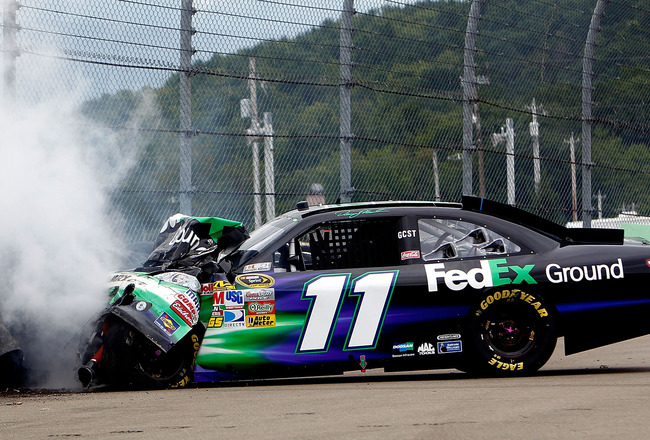


When you're driving a racecar at over 180 mph inches apart from forty-two other cars, chances are pretty good that you're going to hit something. Chances are also good that you're going to hit that something pretty hard. Everyone at Nascar always prided themselves on having the safest cars in motorsports, that is until Feberuary 18th, 2001. That is the day that Dale Earnhardt was killed on the final lap of the Daytona 500. That day changed the sport on many different levels, but perhaps nowhere were its effects felt than on making the sport even safer.
If you've followed Nascar even a little bit over the last decade, you know how much safety has improved. With the installation of SAFER (Steel and Foam Energy Reduction) Barriers at nearly every racetrack to the "Car of Tommorow" body style now used in both the Sprint Cup Series and Nationwide Series, drivers can now walk away from wrecks that years ago may have ended their careers; or their lives.
Last Monday's race at Watkins Glen reminded everyone just how far safety has come and also how far it has to go. The first big wreck occurred when Denny Hamlin's throttle hung entering turn one, sending his No. 11 Toyota into the tire barrier. If you watch the video here, you can see how much the Armco barrier moves behind the tires, but also how much the front of the car gave. This absorbed a lot of the energy that, had those things not done their job, would have been absorbed by Hamlin. Hamlin said afterwards that it was one of, if not the, hardest hits of his career. But while this crash was scary, the one on the final lap would be even worse.
On the final lap, Boris Said unintentionally hooked David Ragan, sending his car into another Armco barrier (No tires this time. All steel.) at a weird angle. This sent him back across the track into David Reutimann's No. 00 into the inside guardrail at a terrible angle as well, which sent the Aaron's Dream Machine flipping into the outside wall. You can watch the video of the last lap here. Both cars were demolished beyond recognition, but while it looked as if the worst had happened, both drivers emerged from their machines unscathed. All of the parts and pieces that flew through the air absorbed energy that would otherwise be directed at the driver. Just as in Hamlins' wreck, the cars did what they were supposed to do.
But there is still room for improvement at the track. Watkins Glen recently underwent a multi-million dollar facelift in the name of driver safety. All of the runoff areas and gravel traps have been paved and some walls had SAFER barriers installed. I think they may be installing a few more before Nascar returns next season. David Ragan told ESPN that he'd raced at dirt tracks with better walls than the ones he'd hit. David Reutimann echoed Ragan's statement, saying he thought where he hit "...would probably be a good place for a SAFER barriers."
These three drivers hit what would be the equivalent of a highway guardrail at around eighty miles per hour while racing at a track in 2011. That's remarkable. Especially after we saw Elliott Saddler hit the same style barrier at Pocono last season. It was an impact so hard that it ripped the engine out, sending it flying, finally coming to rest a few hundred feet from the car. Data later determined that this was the hardest hit in Nascar history.
But Sadler did walk away from his car (after laying on the track to catch his breath) just like Ragan, Reutimann and Hamlin did Monday. When asked what hurt most after his hit, Reutimann jokingly said "my pride." While WGI needs to take a few more steps to improve driver safety, the racecars did their jobs. The only injury occurred when a piece of debris ripped through Reutimann's firesuit and cut his leg during his flip. That's pretty remarkable after seeing the state of the cars after their wild rides. Whatever happens in the race, if all the drivers walk away in one piece, that makes a successful weekend. Hopefully there won't be any hits like we saw at the Glen in Michigan this weekend. Just some close, side by side racing.
No comments:
Post a Comment